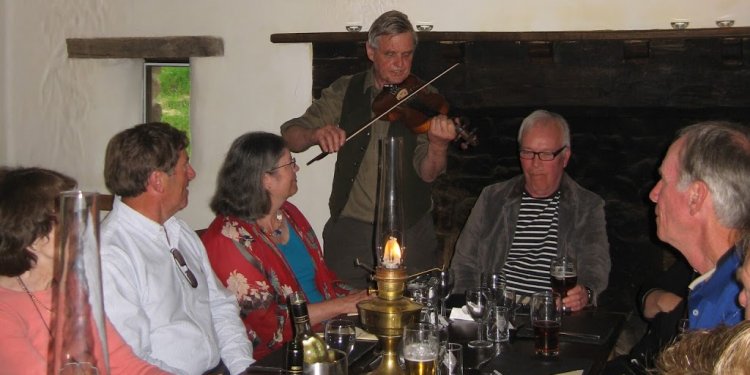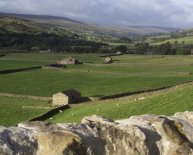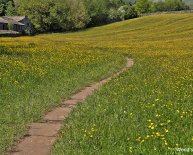
Pub Askrigg England
[from] History of Richmondshire pub.1818–23 [-; complete]
Forty-six line-engravings, by various engravers and in various states, comprising all twenty subjects in the series; various papers and sizes, some annotated in pencil with names of collectors
Purchased (Grant-in-Aid) 1986
Prov: ...; N.W. Lott and H.J. Gerrish Ltd, from whom bt by Tate Gallery (earlier provenance given in individual entries where known)
Lit: David Hill, Turner in Yorkshire, exh. cat., York City Art Gallery 1980; David Hill, In Turner's Footsteps through the Hills and Dales of Northern England, 1984; Eric Shanes, Turner's England 1810–38, 1990
‘Smirke told me’, Farington wrote in his diary for 15 May 1816, ‘that Turner had been engaged to make for a History of Yorkshire: Longman & Co. to be the Publishers: and that he was to have 3000 guineas for his drawings’ (Hill 1984, p.23). A prospectus issued that year announced the publication of ‘A General History of the County of York’ in seven folio volumes.
This project, which has been described as ‘one of the most ambitious ... being undertaken by any publisher at this time’ (ibid), was planned on a large and lavish scale. The author, the Reverend Thomas Dunham Whitaker, Vicar of Whalley and Rector of Heysham in Lancashire, was one of the best-known antiquarian topographers of his day. It was intended from the outset to incorporate into the ‘General History’ many of Whitaker's existing historical publications, such as his History of the Original Parish of Whalley (1800–1), The History and Antiquities of Craven in the Country of York (1805) and a history of Leeds entitled Loidis and Elmete (1816), to all three of which Turner had already contributed designs. In addition, however, Longman's commissioned from Whitaker many new scholarly writings for the project, on Richmondshire, Lonsdale, Lower Swaledale, Nidderdale, the North and East Ridings, as well as York itself and the whole of the district around Sheffield known as Hallamshire (Hill 1984, p.25). The work was to be generously illustrated throughout with, vignettes, plans, maps and genealogical tables, in addition to architectural subjects by John Buckler (1770–1851) and views by Turner. The project was to begin with the ancient district of Richmondshire.
In May 1816 Turner was invited by Longmans to make 120 for the series, at a fee of twenty-five guineas each. This was certainly the most generous remuneration Turner had been offered so far for an project, even allowing for the fact that he had apparently been beaten down to this sum from his suggested fee of forty guineas (Hill 1980, p.73). The thirteen engravers (rather than twelve as given by Herrmann 1990, p.99) meanwhile received between sixty and eighty guineas a plate: they included James Archer (active mid-nineteenth century), Charles Heath (1785–1848), Thomas Higham (1795–1844), John Landseer (1769–1852), Henry Le Keux (1787–1868) and his elder brother John Le Keux (1783–1846), Samuel Middiman (1750–1831), John Pye (1782–1874), William Radclyffe (1783–1855), Samuel Rawle (1771–1860), John Scott (1774–1827), William Raymond Smith (active 1830s-early 1850s) and John Charles Varrall (active 1818–48).
The publishers, however, soon realised that they had overcommitted themselves with these large fees, and in February 1818 - before the first part had even been issued - were already considering selling Turner's watercolours to recoup some of their investment (Hill 1984, p.25). The individual part numbers had been advertised at two prices, four guineas for the large copies (Royal Folio) on India, of which it was intended to about 160; and two guineas for the small paper copies (Demy folio) on plain paper which would number 550 copies (Rawlinson I 1908, p.89). Rawlinson records that all the large paper copies were subscribed to before the work appeared, and over 300 of the smaller issue as well. However, by the time the first part was issued on 1 October 1818, the publishers had decided to limit the issue of the more expensive copies to 125 - whilst still publishing the full complement of 550 copies at the lower price. Of the former eighty-five sold, and of the latter 310. Despite further advertising, sales for subsequent parts settled down to between seventy-one and seventy-seven for the large copies and 241–73 for the small (Hill 1984, p.25). Rawlinson's claim that the Richmondshire series was ‘a success from the first’ cannot, it is clear from this evidence, be substantiated. In addition to the insufficient number of subscribers, however, the project also suffered a serious setback with the untimely death of Whitaker in December 1821 after only five parts had appeared. The remaining seven parts of the History of Richmondshire were issued in quick succession between November 1821 and June 1823, and the whole project was brought to a premature close with only the Richmondshire section completed, containing twenty engravings after Turner. The cost to the publishers for this section alone had been nearly £10, 000; after allowing for turnover, and for the subsequent sale of all remaining stock and copper-plates (in addition to the watercolours by Turner and drawings by Buckler), Longmans declared a profit of a mere £251. 11s. 3 1/2d. (Hill 1984, p.25).
Despite being a commercial failure, however, the Richmondshire series was very popular, and went through many reprints. Rawlinson lists three: Reprint A of 1843 with original descriptions, and published in a thin folio volume by Nichols and Son, London, but notable for its hard and scratchy impressions; Reprint B in the Art Journal of various dates, and in the 1874 edition of The Turner Gallery (Virtue & Co. Ltd); and Reprint C of 1891 in which the plates were sensitively reworked by J.C. Armytage under the direction of Marcus Huish and published by Virtue and Company, with an introduction by Huish and notes on the plates by Mrs Alfred Hunt (Rawlinson I 1908, pp.90–1). By comparison with the Southern Coast (see -), few touched proofs for this series seem to have survived. Most of the impressions in this group are in the first state or from Reprint A; many of them were purchased bound (or in some cases loosely inserted) into an album (, , , , , , , , , , -, , , , , , , and T04484).
















